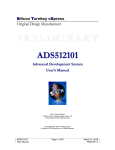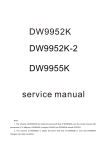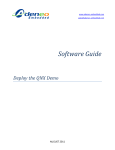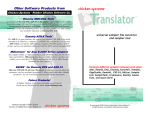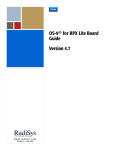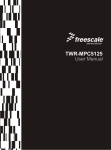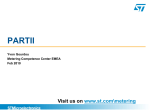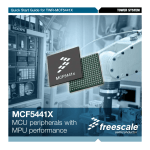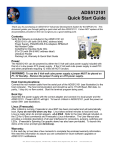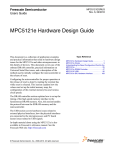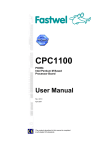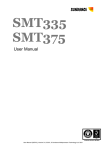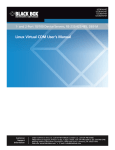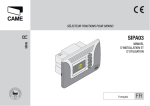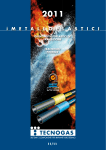Download ADS512101 - Silicon Turnkey Express
Transcript
S s ss es prre Xp ye ey ke nk urrn nT on eX co Siilliic Tu Original Design Manufacturer ADS512101 A Addvvaanncceedd D Deevveellooppm meenntt SSyysstteem m U Usseerr’’ss M Maannuuaall Silicon Turnkey Express 749 Miner Road • Highland Heights, Ohio 44143 Phone (440) 461-4700 • (800) 827-2650 ©Copyright 2006, Silicon Turnkey Express An Affiliate of RPC Electronics Inc., All Rights Reserved. ADS512101 User Manual Page 1 of 56 September 4, 2008 Rev 1.1 Revision History Rev 1.0 1.1 1.2 Date Mar 24, 2008 Sep 4, 2008 Sep 8, 2008 WARNING: Comments Release of user manual for PCB Rev 3 Update for PCB Rev 4 Corrected minor errors and formatting This document is preliminary. It may contain errors and incomplete data. Check with your provider or Silicon Turnkey Express (www.silicontkx.com) or call 440-461-4700) for the latest information. Support: Your ADS512101 does include technical support from STx. If you should encounter any start up problems or if the ADS512101 does NOT include all the material, immediately email [email protected] and provide your name, contact information and problem. STx commits to acknowledging all requests within 4 hours and usually can resolve most issues within 24 hours. Additional support information may be found at www.silicontkx.com Warranty: To assure all future engineering notifications are communicated the enclosed warranty information must be completed. ADS512101 User Manual Page 2 of 56 September 4, 2008 Rev 1.1 NOTICE The information contained within this guide is the property of Silicon Turnkey Express (STx), and except as otherwise indicated shall not be reproduced in whole or in part without the explicit written authorization of STx. The distribution of this document outside of the company is prohibited without the written authorization of STx. The following information is intended to alert the user to possible dangers and important information contained within this guide. The “WARNINGS”, “CAUTIONS” and “NOTES” do not eliminate these dangers. Close attention to the information supplied along with “common sense” operation is the major accident prevention measure. WARNING: Failure to follow this warning may result in bodily injury. CAUTION: Failure to follow this caution may result in possible damage to the board. NOTE: Failure to follow this note may result in improper results from the board. ADS512101 User Manual Page 3 of 56 September 4, 2008 Rev 1.1 Reference Websites Below is a list of websites that can be used to obtain additional information and details that may not be fully provided in this manual. Abatron BDI2000 JTAG Emulator ............................ www.ultsol.com/mfgs_emul_abtr.htm Altera Quartus II………………………………………………………..……. ...www.altera.com CodeWarrior USB TAP ........................................................................ www.freescale.com STx Support Site (Updates & Downloads) ............. www.silicontkx.com/support/index.php 5 Volt Only Operation CAUTION: Failure to follow this caution may result in possible damage to the board. The ADS512101 can operate from either 5 VDC only power supplies, such as the 15 watt wall mounted power supply included in this kit, or an ATX standard power supply. When the ADS512101 is operated with the 15W wall mounted power supply included with this kit normal operation will be LIMITED. The 15 watt, 5 volts operation will NOT provide 12 volts required for peripherals or PCI. However all other ADS512101 function will be normal for worse case maximum power usage. ATX power supplies supports all power for all peripherals and PCI. Follow the instructions in this manual for either 5 volts or ATX operation (see Section 3.2.6). Media Access Control Address Every ADS512101 has a unique MAC address saved in memory as part of the standard environment. A label on the backside of the PCB (under the STx logo) provides the PCB revision number, the serial number, and the MAC address. This same information will appear on a label on the CD container. If the MAC address needs to be set in U-Boot, use these steps: 1 – Boot from main FLASH 2 – Type ‘setenv ethaddr’ MAC Address as ‘00:1E:59:nn:nn:nn’ 3 – If an incorrect MAC address is entered, U-Boot must be re-installed then a new MAC address can be entered. ADS512101 User Manual Page 4 of 56 September 4, 2008 Rev 1.1 Table of Contents 5 Volt Only Operation ...................................................................................................................... 4 Media Access Control Address ....................................................................................................... 4 Table of Contents ............................................................................................................................ 5 Appendix…………………………………………………………………...………………………………..8 List of Included Accessories ............................................................................................................ 9 List of Optional Accessories ............................................................................................................ 9 1.0 General Description ............................................................................................................. 10 1.1 Device Placement and Functions ..................................................................................... 11 1.1.01 BT1 – Battery....................................................................................................... 12 1.1.02 J01 – RJ45, 10/100 BaseT .................................................................................. 12 1.1.03 J02 – Audio Connectors ...................................................................................... 12 1.1.04 J03 – Mini-PCI Connector ................................................................................... 12 1.1.05 J04 – Mini-PCI Connector ................................................................................... 12 1.1.06 J05 – SATA Interface .......................................................................................... 12 1.1.07 J06 – DVI-I........................................................................................................... 13 1.1.08 LED 1 – 5V Good ................................................................................................ 13 1.1.09 LED 2 to 5 – CPLD .............................................................................................. 13 1.1.10 LED 6 – ATA Activity ........................................................................................... 13 1.1.11 LED 7 – USB Power ............................................................................................ 13 1.1.12 P01 – 5V Only Operation..................................................................................... 13 1.1.13 P02 – JTAG Connector ....................................................................................... 13 1.1.14 P03 – Expansion Bus .......................................................................................... 13 1.1.15 P04 – Back Up FLASH ........................................................................................ 13 1.1.16 P05 – CPLD......................................................................................................... 13 1.1.18 P07 – RS232, UART 0 ........................................................................................ 13 1.1.19 P08 – RS232 ....................................................................................................... 13 1.1.20 P09 – CAN 0........................................................................................................ 13 1.1.21 P10 – CAN 1........................................................................................................ 13 1.1.22 P11 – ATA Drive Select....................................................................................... 13 1.1.23 P12 – PATA Connector ....................................................................................... 13 1.1.24 P13 – Front Panel ATA LED ............................................................................... 13 1.1.25 P14 – PCI Connector........................................................................................... 14 1.1.26 P15 – J1850 Interface ......................................................................................... 14 1.1.27 P16 – SPDIF Interface......................................................................................... 14 1.1.28 P17 – Mini USB ................................................................................................... 14 1.1.29 P18 – EEPROM WP............................................................................................ 14 1.1.30 P19 – LCD Backlight Inverter Power................................................................... 14 1.1.31 P20 – LCD Connector ......................................................................................... 14 1.1.32 P21 – LCD Connector ......................................................................................... 14 1.1.34 P22 – Touch Screen Interface............................................................................. 14 1.1.34 P23 – Front Panel Hardware Switch ................................................................... 14 1.1.35 P24 – Front Panel Hibernation Switch ................................................................ 14 1.1.36 P25 – Power Switch By-Pass.............................................................................. 14 1.1.37 P27 – RS232, UART 1 ........................................................................................ 14 1.1.38 P28 – Audio ......................................................................................................... 14 1.1.39 P29 – Micro-SD Socket ....................................................................................... 14 1.1.40 PWR-1 – ATX Power Connector ......................................................................... 15 1.1.41 PWR-2 – DC Power Input.................................................................................... 15 1.1.42 SW1 – Power Switch ........................................................................................... 15 1.1.43 SW2 – Hibernate Switch...................................................................................... 15 1.1.44 SW3 – Mode Switch ............................................................................................ 15 ADS512101 User Manual Page 5 of 56 September 4, 2008 Rev 1.1 Table of Contents 2.0 Hardware Design & Architecture ............................................................................................. 16 2.1 General Description.......................................................................................................... 16 2.2 Physical Specifications ..................................................................................................... 17 3.0 Control & Configuration ....................................................................................................... 18 3.1 Switch Settings ................................................................................................................. 18 3.1.1 SW1 – Power On Reset ...................................................................................... 18 3.1.2 SW2 – Hibernation Mode .................................................................................... 18 3.1.3 SW3 – Boot Mode ............................................................................................... 18 3.2 Jumper Settings................................................................................................................ 19 3.2.1 P01 – ATX Power Supply Operation ................................................................... 19 3.2.2 P04 – Boot Backup FLASH ................................................................................. 19 3.2.3 P11 – ATA Drive Voltage Select ......................................................................... 19 3.2.4 P18 – EEPROM_WP........................................................................................... 19 3.2.5 P25 – Power By-Pass.......................................................................................... 19 3.3 LED Indicators .................................................................................................................. 19 3.4 BT1 Battery....................................................................................................................... 19 4.0 Schematic ............................................................................................................................ 20 5.0 CPLD Configuration............................................................................................................. 21 5.01 CPLD Register 0............................................................................................................... 21 5.02 CPLD Register 1............................................................................................................... 21 5.03 CPLD Register 2............................................................................................................... 21 5.04 CPLD Register 3............................................................................................................... 21 5.05 CPLD Register 4............................................................................................................... 22 5.06 CPLD Register 5............................................................................................................... 22 5.07 CPLD Register 6............................................................................................................... 23 5.08 CPLD Register 7............................................................................................................... 23 5.09 CPLD Register 8............................................................................................................... 24 5.10 CPLD Register 9............................................................................................................... 24 5.11 CPLD Register 10............................................................................................................. 25 5.12 CPLD Register 11............................................................................................................. 25 5.13 CPLD Register 12............................................................................................................. 25 5.14 CPLD Register 13............................................................................................................. 26 5.15 CPLD Register 14............................................................................................................. 26 5.16 CPLD Register 15............................................................................................................. 27 5.17 CPLD Register 16............................................................................................................. 27 5.18 CPLD Register 17............................................................................................................. 28 5.19 CPLD Register 18............................................................................................................. 28 6.0 Operation ............................................................................................................................. 29 6.1 Central Processing Unit.................................................................................................... 29 6.2 Power supplies ................................................................................................................. 29 6.2.1 Power Rails ......................................................................................................... 29 6.2.2 Power Sequencing .............................................................................................. 30 6.2.3 Hibernation Mode ................................................................................................ 31 6.3 Resets............................................................................................................................... 32 6.4 Clocks ............................................................................................................................... 32 6.5 CPU Configuration............................................................................................................ 32 6.6 Interrupts........................................................................................................................... 33 6.7 Memory............................................................................................................................. 33 6.7.1 DDR2 SDRAM..................................................................................................... 33 6.7.2 NOR FLASH ........................................................................................................ 34 6.7.3 NAND FLASH ...................................................................................................... 34 ADS512101 User Manual Page 6 of 56 September 4, 2008 Rev 1.1 Table of Contents 6.8 I/O Function ...................................................................................................................... 34 6.8.01 10/100 Ethernet ................................................................................................... 34 6.8.02 RS232 Port (4-wire)............................................................................................. 34 6.8.03 CAN BUS............................................................................................................. 34 6.8.04 I2C Bus ................................................................................................................ 35 6.8.05 AUDIO and Touch Screen controller................................................................... 35 6.8.06 VIDEO.................................................................................................................. 35 6.8.07 LCD Backlight...................................................................................................... 35 6.8.08 SATA Drive Interface........................................................................................... 35 6.8.09 PATA Drive Interface........................................................................................... 36 6.8.10 PCI....................................................................................................................... 36 6.8.11 Mini-PCI ............................................................................................................... 36 6.8.12 Micro-SD.............................................................................................................. 36 7.0 U-Boot.................................................................................................................................. 37 7.1 Standard Commands........................................................................................................ 37 7.2 Start Up Display................................................................................................................ 38 7.2.1 Auto Linux Boot: .................................................................................................. 38 7.2.2 Graphic Demonstration program (spinning vehicle):........................................... 38 7.2.3 Environment Variables set by U-Boot ................................................................. 39 7.3 Re-Install U-Boot Instructions........................................................................................... 40 8.0 Linux .................................................................................................................................... 42 8.1 Freescale’s Linux BSP ..................................................................................................... 42 8.2 Linux Auto Boot Display: .................................................................................................. 42 ADS512101 User Manual Page 7 of 56 September 4, 2008 Rev 1.1 Appendix Appendix A – Memory Map ........................................................................................................... 45 Appendix B – Connector Pin Assignments.................................................................................... 46 J01 – Ethernet ............................................................................................................................ 46 J02– Audio Jack ......................................................................................................................... 46 J3/J4 – Mini PCI 2/3 ................................................................................................................... 46 J06 – DVI-I.................................................................................................................................. 47 P01 – 5Volt Stand-By ................................................................................................................. 54 P02 – MPC5121e JTAG............................................................................................................. 48 P03 – Expansion Bus ................................................................................................................. 48 P05 – CPLD JTAG ..................................................................................................................... 49 P06 – UART 0 ............................................................................................................................ 49 P07 – UART 0 ............................................................................................................................ 49 P08 – UART 1 ............................................................................................................................ 50 P08 – UART 1 ............................................................................................................................ 50 P09 – CAN 0 .............................................................................................................................. 50 P10 – CAN 1 .............................................................................................................................. 50 P12 – PATA Connector .............................................................................................................. 50 P13 – ATA Activity...................................................................................................................... 51 P14 – PCI ................................................................................................................................... 51 P15 – J1850 ............................................................................................................................... 52 P16 – SPDIF .............................................................................................................................. 52 P17 – USB Mini AB Connector .................................................................................................. 52 P19 – LCD Backlight .................................................................................................................. 52 P20 – LCD (LVDS) Connector ................................................................................................... 53 P21 – LCD (TFT 18bit) ............................................................................................................... 53 P22 – LCD Touchscreen ............................................................................................................ 53 P23 – Power Switch ................................................................................................................... 53 P24 – Hibernate Switch.............................................................................................................. 53 P27 – UART 1 Interface ............................................................................................................. 53 P28 – Audio ................................................................................................................................ 54 P29 – Micro-SD .......................................................................................................................... 54 PWR-1 – ATX Power Connector................................................................................................ 54 PWR-2 – 5V Power Connector................................................................................................... 54 Acronyms....................................................................................................................................... 55 ADS512101 User Manual Page 8 of 56 September 4, 2008 Rev 1.1 List of Figures Figure 1 – ADS512101.................................................................................................... 10 Figure 2 – ADS512101 Top Board Layout ...................................................................... 11 Figure 3 – ADS512101 Bottom Board Layout................................................................. 12 Figure 4 – ADS512101 Block Diagram ........................................................................... 16 Figure 5 – ADS512101.................................................................................................... 17 Figure 6 – U-Boot Start Up Screen………………………………………………. ............... 38 Figure 7 – U-Boot Re-Install Screen…………………….. ................................................ 41 List of Included Accessories • • • • • • User Manual (on CD) Schematic (on CD) 5V, 15W Wall Mount Power Supply Null Modem Cable CodeWarrior (Windows & Linux) Additional Freescale collateral material (on CD) List of Optional Accessories These accessories are available from Silicon Turnkey Express. See the enclosed order form or visit web site: Accessories Add-On Features • • • • • • • • • • • • • • • • • • • • • • Cases with custom silkscreen Backplates/Custom silkscreen LCDs, Inverter, Touchscreen Monitors, Touchscreen USB 802.11 Radio MiniPCI WiMAX Radio DRAM Modules Memory Upgrades Hard Drive (IDE or SATA) Solid State Hard Drive (FLASH) CD-ROM or DVD Drive Wall Cube Power Supplies Internal Power Supplies PCI Riser Cards Peripherals inside the case Cables (All kinds & Customs) ADS512101 User Manual Bluetooth ® Radio Camera/Image Capture Microphone GPS module Echo Cancellation module Profibus/Fieldbus Software • • • • • • • • • Page 9 of 56 Operating Systems Graphic Solutions Cellular Connectivity GPS Location Touchscreen Bluetooth ® Technology Voice Recognition Wireless Database Client September 4, 2008 Rev 1.1 1.0 General Description The ADS512101 Advanced Development System is a mini-ITX formfactor reference and mother board based on Freescale’s MPC5121e microprocessor. The board will provide on-board DDR SDRAM, NOR FLASH, NAND FLASH, (2) 4 wire RS232 ports, 2 CAN ports, USB 2.0, 10/100 Ethernet, Audio in/out/mic, SATA and PATA drive support, PCI, Micro-SD, 24bpp graphics, all powered from a standard ATX or 5 Volt wall mount power supply. The board can be integrated into any configuration required by the addition of optional peripherals. These would include items such as enclosures, displays, HDD and numerous other mini-ITX accessories. Figure 1 – ADS512101 Silicon Turnkey Express will work with your embedded systems engineers to integrate a final product that will give your end users the best performing and most cost effective embedded solution. ADS512101 User Manual Page 10 of 56 September 4, 2008 Rev 1.1 1.1 Device Placement and Functions This section provides a description of the connectors, jumpers, switches and main components of the ADS512101 board. Refer to Figures 2 and 3 for location of the devices referenced below. Additional descriptions of the functionality of switches and jumpers along with their recommended settings will be found in Section 3 of this manual. Figure 2 – ADS512101 Top Board Layout ADS512101 User Manual Page 11 of 56 September 4, 2008 Rev 1.1 Figure 3 – ADS512101 Bottom Board Layout 1.1.01 BT1 – Battery 1.1.04 J03 – Mini-PCI Connector Use a 3 Volt Lithium button battery. PCB Rev 1.x and 2.x used type CR2032 or equivalent. PCB Rev 3.x or higher uses CR1220 or equivalent. (See Figure 3) J3 is a Mini-PCI 32 bit connector with +3.3v that uses ID_SEL_AD22. 1.1.05 J04 – Mini-PCI Connector J1 is a standard Ethernet input jack. (See Figure 3) J4 is a Mini-PCI 32 bit connector with +3.3v that uses ID_SEL_AD23. 1.1.03 J02 – Audio Connectors 1.1.06 J05 – SATA Interface J2 has three stereo connection, J2A (Blue) is Line In; J2B (Green) is Line Out; J2C (Pink) is Aux In. J5 is the serial ATA interface connector. 1.1.02 J01 – RJ45, 10/100 BaseT ADS512101 User Manual Page 12 of 56 September 4, 2008 Rev 1.1 1.1.07 J06 – DVI-I 1.1.16 P05 – CPLD J6 is the Digital Video Interface. Header P05 is a CPLD JTAG port for programming and application debugging of the CPLD. 1.1.08 LED 1 – 5V Good Indicates when 5 Volts is on. An Altera Quartus II with a Byteblaster cable or equivalent programming kit should be used. 1.1.09 LED 2 to 5 – CPLD Is user definable by the CPLD. 1.1.18 P07 – RS232, UART 0 1.1.10 LED 6 – ATA Activity Indicates when ATA data fetches occur. P7 is a 9-pin “D” style connector for serial communications. 1.1.19 P08 – RS232 1.1.11 LED 7 – USB Power P8 is a header connector for an additional RS232 connector. See Appendix B for pin out. Indicates when USB power is on. 1.1.12 P01 – 5V Only Operation See Jumpers Section 3.2.6. 1.1.20 P09 – CAN 0 1.1.13 P02 – JTAG Connector P9 is a 9-pin “D” style connector for Control Area Network. Connector P02 is a 16-pin header used for the COP/JTAG input. This port is made available to aid in the programming of the ADS512101. The pin-outs for the connector are listed in Appendix A A JTAG interface device, such as the Abatron’s BDI2000 or Freescale’s CW USB TAP or equivalent, should be used. P10 is a header connector for an additional CAN connector. See Appendix B for pin out. 1.1.22 P11 – ATA Drive Select See Jumper Section 3.2.3. 1.1.23 P12 – PATA Connector 1.1.14 P03 – Expansion Bus P03 provides signals for EMB, PLC, and GPIO. See Appendix C for pin out. P12 is a 40 pin connector for attaching an optional parallel device. 1.1.24 P13 – Front Panel ATA LED 1.1.15 P04 – Back Up FLASH Normally Open A jumper is used to re-FLASH U-Boot to main FLASH. See Section 7.3, ReInstalling U-Boot Instructions. ADS512101 User Manual 1.1.21 P10 – CAN 1 P13 is a 2-pin header used to enable the front panel LED. Page 13 of 56 September 4, 2008 Rev 1.1 1.1.25 P14 – PCI Connector 1.1.34 P14 is the standard PCI connector that uses ID_SEL_AD21. 1.1.26 P15 – J1850 Interface P15 is a serial connection for J1850. P23 – Front Panel Hardware Switch P23 is a header to provide a connection for the Front Panel Hardware Reset switch SW 1. Push once (momentary) Power on Reset. 1.1.27 P16 – SPDIF Interface P16 is a connection (header) for the SPDIF to the MPC5121e. 1.1.28 P17 – Mini USB P17 is a USB mini AB connector that is compatible with the USB 2.0 format. causes a Push and hold for 5 seconds causes a power down. 1.1.35 P24 – Front Panel Hibernation Switch P24 is a header to provide a connection for the Front Panel Hibernation mode switch SW2. 1.1.29 P18 – EEPROM WP See Jumper Seciton 3.2.2. 1.1.36 P25 – Power Switch ByPass 1.1.30 P19 – LCD Backlight Inverter Power This provides power and control signals to an LCD Inverter. This jumper is used to by pass the power switch to allow for remote access by applying power to the ADS512101. 1.1.37 P27 – RS232, UART 1 This is a 20 pin LVD connector. This is a 10 pin header to accommodate an external serial port. 1.1.32 P21 – LCD Connector 1.1.38 P28 – Audio 1.1.31 P20 – LCD Connector This connector is for a TFT, 18bit LCD to accommodate Media5200 monitors. This is a 10 pin header to accommodate external audio connections. 1.1.34 P22 – Touch Screen Interface 1.1.39 P29 – Micro-SD Socket This is an enhancement that may is not available on the standards ADS512101. ADS512101 User Manual (See Figure 3) P29 allows use of any Micro-SD memory. Page 14 of 56 September 4, 2008 Rev 1.1 1.1.40 PWR-1 – ATX Power Connector 1.1.42 SW1 – Power Switch See Switch Settings, Section 3.1.1 PWR-1 is the main ATX power input connector for the ADS512101. It is designed to use a standard 20-pin ATX power supply. 1.1.43 SW2 – Hibernate Switch 1.1.41 PWR-2 – DC Power Input 1.1.44 SW3 – Mode Switch PWR-2 is the 5VDC to the board. P01 needs to be installed to enable the on board power signal. See Section 3.2.1. See Switch Settings, Section 3.1.3 ADS512101 User Manual See Switch Settings, Section 3.1.2 Page 15 of 56 September 4, 2008 Rev 1.1 2.0 Hardware Design & Architecture 2.1 General Description Some of the features of the ADS512101 are: • • • • • • • • • • • Freescale Processor MPC5121e DDR2 RAM module- capacity 512Mbyte to 2 Gbytes JTAG and control CPLD LVDS 24-bit (LCD) or CMOS (Rev3) RS-232 and CAN port USB A, B and OTG NOR, NAND and backup FLASH Local bus IO connector Stereo Audio (AC97) SATA/PATA (IDE), Micro-SD PCI/mini-PCI (radio slots) SATA SATA 7 pin DDR2 DDR2 D 1 6 D 1 6 Standard 32-bit PCI slot SATA DDR1/2 Memory Interface Mini USB Type AB USB 2.0 Magnetics RJ45 10/ 100 PHY 10/100 ENet UTMI USB OTG PHY RMII 10/100 MII / RMII PSC0, PSC1, PSC2 Mini-PCI 32-bit slot 32bit Mini-PCI 32-bit slot PCI 2.3 Interface PCI, 32bit, 33/66 MHz MicroSD PATA Control DB9 CAN CAN Transceiver CAN CAN Bus port 0 CAN Bus port 1 Buffers Signal Level shifters PATA 2X5 Header PATA DB9 RS232 RS232 Transceiver 2X5 Header Audio Jacks Analog Audio Line IN Line OUT MIC IN Audio Codec PSC / UART PSC / AC97 Rs232 PSC3, UART 0 PSC4, UART 1 Audio AC97 PSC5 D 16 SDATA TEMP SENSO R EEPRO M I2C port 0 I2C port 2 SPDIF EXP Header 2x40 Pin D 32 CPLDs CLK C P U R es et s SPDIF 1x3 Header D8 EMB AD Bus 32bit AD 32 Peripher al Reset C t l NAND FLASH 8bit NOR Backup Boot FLASH D 16 Local Memory Bus Controller EMB NAND FL Controller PATA 40 Pin PATA CPU Configuratio n Address latch L_ADD NOR Boot FLASH X32 Power Supplies +3.3v +2.5v +1.8v +1.4v +1.2v +0.9v Power Supply sequence Board Resets 20 pin LVDS LVDS LVDS Transmitter Video MPC5121 TFT 24Bit Resets SYS-33mhz DIV-I Connector LVDS DVI Driver Eth-25mhz SATA-25mhz Audio-24.576 VG A Buff VGA DAC Analog PCI-33/66mhz CPLD-33mhz +5.0v Standby Power on Reset Cocks; System Ethernet SATA Audio PCI CPLD Configuratio n Switches ATX Power Provides 12V (20pin) Standby Power +3.3v 5.0v +5v connector (No 12V) Figure 4- Block Diagram of ADS512101 Board ADS512101 User Manual Page 16 of 56 September 4, 2008 Rev 1.1 2.2 Physical Specifications This section contains general information on the ADS512101’s physical characteristics. Figure 5 – ADS512101 Side View Board Size...............................................................................mini-ITX (170mm x 170mm) Power Requirement ...................................................................................... ATX or 5VDC Operating Temperature Standard Version.......................................................................00 to +700C Industrial Version....................................................................-400 to +850C Weight ......................................................................................................................... 200g RoHS................................................................................................................... Compliant ADS512101 User Manual Page 17 of 56 September 4, 2008 Rev 1.1 3.0 Control & Configuration This section contains general set-up information about the various jumpers, switches, and LEDs found on the ADS512101 board. Section 3.1 describes the function and recommended switch settings. Section 3.2 describes the function and recommended jumpers on the board. Section 3.3 describes the LED indicator function. 3.1 Switch Settings SW3 Boot Mode (Continued) This section provides a brief description of the functionality and recommended settings for the switches located on the ADS512101. SW3 is the CPLD Boot Configuration Reset functions of the ADS512101. Refer to CPLD Register 18, Section 5.19 for additional information. Refer to Figure 2 for the locations of these switches. SW3 is a single-pole single-throw (SPDT) 8-position switch used to configure the CPLD for booting the ADS512101 during power-up. 3.1.1 SW1 – Power On Reset SW1 is a push button that provides a power on reset signal for the hardware on the ADS512101. The push button can be remotely locate with connector P27. Push once to power on board and push and hold for five seconds to power down board. 3.1.2 SW2 – Hibernation Mode SW2 provide a hibernation request to the ADS512101. Push once to put ADS512101 in hibernation mode. Push again to bring ADS512101 out of hibernation. 3.1.3 SW3 – Boot Mode CAUTION: Failure to follow this caution may result in possible damage to the board. All switches should be set to factory default, normal operation, ‘ON’. Pos. 1 State ON 1 OFF Low Boot 2 ON NOR Boot 2 OFF NAND Boot 3 3 ON OFF PCI = 33MHz 4 4 ON OFF 5 5 6-7 6-7 6-7 6-7 8 8 ON OFF OFF-OFF ON-OFF OFF-ON ON-ON ON OFF Function High Boot PCI = 66MHZ* Watchdog Disabled Undefined Core PLL = 1.5x Core PLL = 2x DDR2 = 200MHz DDR2 = 166.67MHz DDR2 = 133.33MHz DDR2 = 133.33MHz Reserved Reserved *M66en must also be high for 66mhz For proper operation these switches should be left in the factory default position. ADS512101 User Manual Page 18 of 56 September 4, 2008 Rev 1.1 3.2 3.2.4 P18 – EEPROM_WP Jumper Settings This section provides a brief description of the functionality and recommended settings for the jumpers located on the ADS512101. Refer to Figure 2 for the locations of these jumpers. Default Open With this jumper installed the EEPROM can be accessed allowing it to be programmed or erased as needed. When the jumper is removed the EEPROM cannot be programmed. 3.2.1 P01 – ATX Power Supply Operation 3.2.5 P25 – Power By-Pass Default Open This jumper must be installed to use an external 5volt power supply connected to PWR-2. It must be removed to use an ATX power supply. Default Open With this jumper iinstalled the Power On switch is by-passed. The ADS512101 will launch U-Boot when power is applied. 3.2.2 P04 – Boot Backup FLASH 3.3 Default Open When this jumper is installed powering the ADS512101 will launch U-Boot in a protected back up FLASH and reinstall U-Boot to main FLASH. 3.2.3 P11 – ATA Drive Voltage Select CAUTION: Failure to follow this caution may result in possible damage to the board. Be sure to select the correct voltage setting for the drive used prior to turning the power on to the board. Default +3.3 Volts, Pins 1&2 Jumper P21 selects the appropriate power setting (+3.3 or +5.0) per the ATA specification for the drive in use. Pin No 1-2 2-3 ADS512101 User Manual LED Indicators This section provides a list of functions for the LEDs on the ADS512101 board. Refer to Figure 2 for the locations of these LEDs. See CPLD Register 17, Section 5.18, for additional information. LED 1 2 3 4 5 6 3.4 Function 5VDC GOOD USER DEFINED USER DEFINED USER DEFINED USER DEFINED ATA ACTIVITY Color GREEN RED YELLOW GREEN GREEN GREEN BT1 Battery Use only a 3 Volt Lithium battery, properly sized for the socket. The battery is used for the Real Time Clock. The Real Time Clock in conjunction with the CPLD releases the Power Rail Regulators. See Section 6.2.1 for more information. Description PATA 3V PWR PATA 5V PWR Page 19 of 56 September 4, 2008 Rev 1.1 4.0 Schematic The schematic and basic assembly information in a portable document format for the ADS512101 can be located on the CD in the STx Engineering Document Folder supplied with the board. The ADS512101 design can be customized for optional flexibility and custom interfaces so the embedded systems engineer can obtain a lower overall parts cost using a variety of fixed and user selectable options. These options inherently are contained in connectors, jumpers and switches on the board. The schematic provides guidelines for using the already installed as well as user modifiable options available on the present design. ADS512101 User Manual Page 20 of 56 September 4, 2008 Rev 1.1 5.0 CPLD Configuration The configuration CPLD controls the MPC5121e hard reset configuration word. The hardware configuration is controlled by switches SW3 to SW5 (see section 3.1.3 through 3.1.7) and documented in the following CPLD table. If all switches are set to ON, then the CPLD will drive the default configuration word. Other functions of the CPLD are driven by or read by internal registers that are memory mapped at the base address 0x6000_0000. The CPLD uses the MPC5121e’s chip select 2 on the local bus as its chip select and address decodes the lower 5 address bits. See the following table of CPLD registers descriptions for additional information. 5.01 CPLD Register 0 Board ID 1, used along with register 1 Base + 0x00 Bit # 7-0 5.02 A distinct board ID is assign to the board, 16bits 0x0001 = ADS5121e rev 04 Upper byte of Board ID Value at reset Ability R/ W 0x00 Read only Value at reset Ability R/ W 0x04 Read only Value at reset Ability R/ W 0x01 Read only CPLD Register 1 Board ID 0, used along with register 0 Base + 0x01 Bit # 7-0 5.03 Bit description Upper byte of Board ID CPLD Register 2 CPLD Revision Base + 0x02 Bit # 7-0 5.04 CPLD rev CPLD rev info Writing a sequence of AA then 55 then 96 CPLD Register 3 Configuration word bits 33..32 Base + 0x03; 0x1010_1000 = default, CPLD drives Reset Configuration Word Bit # 7-2 This register is reserved Reserved Value at reset Ability R/ W 101010 Read / Write 1 RST_CONF_EMB_AX2 CFG_word_33 Read only 0 RST_CONF_EMB_AX3 CFG_word_32 Read only ADS512101 User Manual Page 21 of 56 September 4, 2008 Rev 1.1 5.05 CPLD Register 4 Configuration word bits 31..24 Base + 0x04; 0x0000_0001 = default, CPLD drives Reset Configuration Word Bit # Value at reset Ability R/ W 7 Ability to read Configuration switches through software Switch definitions are from 5121 user manual HRW RST_CONF_SYSDIV, EMB_AX0 driven 0 CFG_word_31 Read only 6 RST_CONF_SYSDIV System PLL divider CFG_word_30 Read only 5 RST_CONF_SYSDIV CFG_word_29 Read only 4 RST_CONF_SYSDIV CFG_word_28 Read only 3 RST_CONF_SYSPLL System PLL Multiply factor CFG_word_27 Read only 2 RST_CONF_SYSPLL CFG_word_26 Read only 1 RST_CONF_SYSPLL CFG_word_25 Read only 0 RST_CONF_SYSPLL CFG_word_24 Read only 5.06 CPLD Register 5 Configuration switch settings (EMB_AD[23:16]) Base + 0x05; 0x1000_1101 = default, CPLD drives Reset Configuration Word Bit # Value at reset Ability R/ W 7 Ability to read Configuration switches by software Switch definitions from 5121 user manual HRW RST_CONF_SYSPLL System PLL Multiply factor CFG_word_23 Read only 6 RST_CONF_CKS_IN Checkstop disabled CFG_word_23 Read only 5 RST_CONF_NFC_DBW NAND data port 8bit CFG_word_21 Read only 4 RST_CONF_NFC_PS NAND FLASH page size 2Kbytes CFG_word_20 Read only 3 RST_CONF_LPC_DBW LPC DATA port 11 =32 bit CFG_word_19 Read only 2 RST_CONF_LPC_DBW CFG_word_18 Read only 1 Reserved, not mentioned in manual CFG_word_17 Read only 0 RST_CONF_LPC_MX LPC Multiplexed mode CFG_word_16 Read only ADS512101 User Manual Page 22 of 56 September 4, 2008 Rev 1.1 5.07 CPLD Register 6 Configuration switch settings (EMB_AD[15:8]) Base + 0x06; 0x0101_0000 = default, CPLD drives Reset Configuration Word Bit # 7 6 5 4 3 2 1 0 5.08 Ability to read Configuration switches through software Switch definitions are from 5121 user manual HRW Value at reset Ability R/ W RST_CONF_PCIARB enable PCI arbiter RST_CONF_PCIHOST PCI Host mode RST_CONF_COREPLL Core PLL Multiply factor RST_CONF_COREPLL Core PLL Multiply factor RST_CONF_COREPLL Core PLL Multiply factor RST_CONF_COREPLL Core PLL Multiply factor RST_CONF_LPC_AX No LPC Address Extension RST_CONF_LPC_AX No LPC Address Extension CFG_word_15 CFG_word_14 CFG_word_13 CFG_word_12 CFG_word_11 CFG_word_10 CFG_word_09 CFG_word_08 Read only Read only Read only Read only Read only Read only Read only Read only CPLD Register 7 Configuration switch settings (EMB_AD[7:0]) Base + 0x07; 0x0010_0000 = default, CPLD drives Reset Configuration Word Bit # Value at reset Ability R/ W 7 Ability to read Configuration switches by software Switch definitions from 5121 user manual HRW RST_CONF_PCI66EN M66EN signal, 1 = 66 CFG_word_07 Read only 6 RST_CONF_TLE Little ENDIAN CFG_word_06 Read only 5 RST_CONF_BMS boot high CFG_word_05 Read only 4 RST_CONF_COREDIS Core Disable mode (normal) CFG_word_04 Read only 3 RST_CONF_TPR factory test mode disabled CFG_word_03 Read only 2 RST_CONF_SWEN watchdog timer disabled at reset CFG_word_02 Read only 1 RST_CONFIG_ROM_LOC LPC boot CFG_word_01 Read only 0 RST_CONFIG_ROM_LOC LPC boot CFG_word_00 Read only ADS512101 User Manual Page 23 of 56 September 4, 2008 Rev 1.1 5.09 CPLD Register 8 NOR FLASH Control Base + 0x08 0x00000000 = default configuration, CPLD drives Reset Configuration Word Bit # 7 Back up FLASH Write Protect 1 = (Full) write protected Write enable signal held high Value at reset 1 Ability R/ W Read / Write 6 5 Back up FLASH sector write protect Boot FLASH Write Protect 1 = (Full) write protected Write enable signal held high 1 1 Read / Write Read / Write 4 3 2 Boot FLASH sector write protect NOR_FL_RDY Boot or Backup FLASH status, 0 = Backup; 1 = Boot Dependant on P4 Jumper, jumper installed = Backup 1 1 x Read / Write Read only Read only Or if 0xAA is written to register 2, R/W Control is immediate Backup NOR FLASH reset, will be released from reset, at power up, if configuration is set for Backup FLASH 1 0 5.10 Boot NOR FLASH reset will be released from reset, at power up, if configuration is set for Backup FLASH Read/Write 0 Read / Write 1 Read / Write Value at reset Ability R/ W 0 Read only CPLD Register 9 NAND FLASH, CAN, MEDIA_GPIO Control Base + 0x09 Bit # 7 Currently only NAND chip select 0 is used, chip select 1-3 are for future expansion. MEDIA_GPIO 6 Reserved 0 Read / Write 5 Reserved 0 Read / Write 4 CAN Shut Down 0=Shut Down 0 Read / Write 3 NAND FLASH CE3 # enable 0=enabled 1 Read / Write 2 NAND FLASH CE2 # enable 0=enabled 1 Read / Write 1 NAND FLASH CE1 # enable 0=enabled 1 Read / Write 0 NAND FLASH CE0 # enable 0=enabled 0 Read / Write ADS512101 User Manual Page 24 of 56 September 4, 2008 Rev 1.1 5.11 CPLD Register 10 PCI Interrupt Masking Base + 0x0A Bit # 1 = interrupt is masked Value at reset Ability R/ W 7 PCI_INTB_SLOT3 1 Read / Write 6 PCI_INTA_SLOT3 1 Read / Write 5 PCI_INTB_SLOT2 1 Read / Write 4 PCI_INTA_SLOT2 1 Read / Write 3 PCI_INTD_SLOT1 1 Read / Write 2 PCI_INTC_SLOT1 1 Read / Write 1 PCI_INTB_SLOT1 1 Read / Write 0 PCI_INTA_SLOT1 1 Read / Write 5.12 CPLD Register 11 PCI Interrupt Status Base + 0x0B Bit # 7 PCI interrupts are received at the CPU on the PCI_INTN signal, this is a dedicated input on the CPU, 0 = pending, corresponding mask bit also must be cleared PCI_INTB_SLOT3 6 PCI_INTA_SLOT3 1 Read only 5 PCI_INTB_SLOT2 1 Read only 4 PCI_INTA_SLOT2 1 Read only 3 PCI_INTD_SLOT1 1 Read only 2 PCI_INTC_SLOT1 1 Read only 1 PCI_INTB_SLOT1 1 Read only 0 PCI_INTA_SLOT1 1 Read only Value at reset Ability R/ W 0 Read / Write 5.13 Value at reset Ability R/ W 1 Read only CPLD Register 12 Interrupt Routing Selection between CPU IRQ0 or IRQ1 Base + 0x0C Bit # 7 Controls which IRQ is used for the listed IRQs 0 = CPU_IRQ0, 1 = CPU_IRQ1 SW1_HIBERNATE# 6 Secure Digital Card (SD_CD#) 0 Read / Write 5 TOUCH_SCR_BUSYN 0 Read / Write 4 TOUCH_SCR_IRQN (off board) 0 Read / Write 3 FEC_PHY_INTN 0 Read / Write 2 TEMP_MON_INT 0 Read / Write 1 PCI Interrupts 0 Read / Write 0 RTC_INT# 0 Read / Write ADS512101 User Manual Page 25 of 56 September 4, 2008 Rev 1.1 5.14 CPLD Register 13 Interrupt Masking Base + 0x0D Bit # 1 = interrupt is masked Value at reset Ability R/ W 7 SW1_HIBERNATE#, writing 0 clears INT in register 14 1 Read / Write 6 Secure Digital Card (SD_CD#) 1 Read / Write 5 TOUCH_SCR_BUSYN 1 Read / Write 4 TOUCH_SCR_IRQN (off board) 1 Read / Write 3 FEC_PHY_INTN 1 Read / Write 2 TEMP_MON_INT 1 Read / Write 1 ALL PCI INT MASKING to CPU 1 Read / Write 0 RTC_INT# 1 Read / Write Value at reset 1 Ability R/ W Read/Write 1 Read/Write 5.15 CPLD Register 14 Interrupt Status Base + 0x0E Bit # 7 6 SW1_HIBERNATE# Must be cleared by writing value ‘0’ to register 13 bit 0 Secure digital card (SD)CD#) 5 Reserved 1 Read/Write 4 TOUCH_SCR_IRQN (off board) 1 Read/Write 3 FEC_PHY_INTN 1 Read/Write 2 1 TEMP_MON_INT PCI INT, read CPLD register 11 for which PCI interrupt is asserted RTC_INT# 1 1 Read only Read/Write 1 Read/Write 0 ADS512101 User Manual Page 26 of 56 September 4, 2008 Rev 1.1 5.16 CPLD Register 15 MISC Control 0 Base + 0x0F Bit # 7 Value at reset Ability R/ W 0 Read / Write 6 Hibernation event, must write ‘0’ to clear this bit. This was removed and needs to be read within the CPU. See Hibernation Section 6.2.3 for detailed explanation. TOUCH_RESET# (on board touch screen U38) rev 4 only 0 Read / Write 5 UART0_FOFF# 1 Read / Write 4 UART1_FOFF# ADS5121e_Rev 4 only 1 Read / Write 3 1 Read only 1 Read only 1 TOUCH_1_IRQ#_MASKING (on board touch screen U38) rev 4 only TOUCH_1_IRQ# STATUS (on board touch screen U38) rev 4 only. CPU IRQ Routing is the same as set for the off board touch screen controller. Register 12 bit 4 PATA_RESET 1 Read only 0 FEC_PHY_RSTN 1 Read only Value at reset Ability R/ W 2 5.17 CPLD Register 16 Video Control 1 Base + 0x010 Bit # 7 LCD_LVDS_FRAME_RATE 0 Read / Write 6 Reserved 0 Read / Write 5 DVI_MSEN 0 Read only 4 LCD_LVDS_SDIRn 0 Read / Write 3 Reserved 0 Read only 2 DVI_DAC_PWRDNn 0 Read only 1 VGA_DAC_PWRDNn 0 Read only 0 LCD_PWR_DWNn 0 Read only ADS512101 User Manual Page 27 of 56 September 4, 2008 Rev 1.1 5.18 CPLD Register 17 User LED Base + 0x011 Bit # 7 Value at reset Ability R/ W 0 Read / Write 0 Read / Write 0 Read / Write 0 Read / Write 3 LED 3 Control, 0=LED0=Reset Status; 1=User Control register 17 (0) LED 2 Control, 0=LED0=Reset Status; ; 1=User Control register 17 (0) LED 1 Control, 0=LED0=Reset Status; ; 1=User Control register 17 (0) LED 0 Control, 0=LED0=Reset Status; ; 1=User Control register 17 (0) LED 3 0 Read / Write 2 LED 2 0 Read / Write 1 LED 1 0 Read / Write 0 LED 0 0 Read / Write 6 5 4 5.19 CPLD Register 18 Configuration Switch Settings, SW3 Base + 0x012 7 SW3 Position 8 5-6 7&6 cfg_sys_pll 00 = 200mhz DDR2 clock 01 = 166.67mhz DDR2 clock 10 = 133.33mhz DDR2 clock 00 Read only 4 5 cfg_core_pll 0 = 2x 1= 1.5x 0 Read only 3 4 cfg_watchdog 0 = disabled 0 Read only 2 3 0 = 33mhz 0 = disabled cfg_PCI_speed M66en signal also must be high for 66mhz 0 Read only 1 0 2 1 cfg_NOR_boot 0 = NOR boot cfg_LOW-bo0t 0 = high boot 0 0 Read only Read only Bit # ADS512101 User Manual Function Description Reserved Page 28 of 56 Value at reset 0 = OFF 0 Ability R/W Read only September 4, 2008 Rev 1.1 6.0 Operation All information contain this section is from STx’s Design Requirements revision 4.0 dated August 27, 2008. For additional information or clarifications visit web site: www.silicontkx.com/support/index.php or email [email protected]. 6.1 Central Processing Unit The ADS512101’s MPC5121e is configured to run at a 33 Mhz system clock, and asynchronous mode 66 Mhz/33 Mhz PCI clock frequency. The initial configuration is driven from the main CPLD reading the configuration of switch SW3. The boot strap options will be selectable from a configuration dip switch read by the CPLD, the actual boot strap pins will be driven by the CPLD during reset only. The switch setting can also be read from the CPLD, see CPLD register 18. The MPC5121 will be responsible for the PCI arbitration and interrupt controller. The MCP5121 provides te interface to local on board resources including: NOR FLASH memory, NAND FLASH memory, DDR2-SDRAM memory, CPLD, MII (10/100 Fast Ethernet Controller), I2C (EEPROM, STM), PSC (programmable serial controller) for RS232 and AC97 (audio), Interrupt controller, USB 2.0 (ULPI), PCI bus, PCI controller, Graphics (on chip MBX) controller, PATA controller, SATA controller and Micro-SD. See MPC5121e user manual for detail descriptions for each interface. 6.2 Power supplies The ADS512101 board requires a mini-ATX power supply (20 pins connector can be used) or a 5v external power supply. When using a 5v external power supply functions requiring 12v will not operate. If a 5v external power supply is used jumper P1 is required. The jumper connects the 5v with the 5v-stby voltage which is required for the power up circuitry. 6.2.1 Power Rails The ADS512101 board requires several power rails that are provided on board, and include: +1.4v @ TBD for the CPU Core voltage. +1.2v @ 0.5A for the CPU Core voltage. +1.8v @ 4A for the CPU Core voltage. +0.9v @ 3.3A for the CPU Core voltage. +3.3v @ 2.0A for the CPLD, reset circuitry, clocks. CPU I/O, and peripheral logic. +12v @ 2A (direct input from off-board power supply) for disk drive power and LCD. ADS512101 User Manual Page 29 of 56 September 4, 2008 Rev 1.1 Power Rails (continued) The power enables for each of the regulators are used to sequence the power supplies. These will not release if the CPLD is not powered properly and the RTC clock are not running. These are open drain signals and work in tandem with the SS RC time constants of the regulators. They are used to Power-down the regulators in 0 time but allow the time constants of SS for Power-up. 6.2.2 Power Sequencing Power sequencing rules require that the IO voltage rail is powered before the Core Voltages. This is controlled by the SS time constants of the Core regulators are longer than that of the IO regulators. During “sequenced” power down the CPLD will disable the Core regulators first and then disable the IO Regulators. The normal controlled power down sequence will be (on SW1 Toggle). 1: Assert PON_RESET (via MASTER_RESETN). 2: De-assert core Power - ENA_1V4, ENA1V2. 3: Wait some time. 4: De-assert IO Power - ENA_3V3, ENA2V5….etc. 5: De-assert (ATX)-POWER_ONN. The Normal Power-UP sequence will be (on SW1 Toggle). 1: Assert (ATX)-POWER_ONN. 2: Assert IO Power - ENA_3V3, ENA2V5….etc. 3: Wait some time. 4: Assert core Power - ENA_1V4, ENA1V2. 5: Assert PON_RESET (via MASTER_RESETN). The CPLD and the 8bit I/O expander control the power up and power down of the entire board. Power On Sequencing If “Power_ON” is used This is generated from PB Switch PS1 Toggle and “Not Hibernate”. If Hibernating the power will shut down and this must be toggled POWER_ONN Power Up Delayed by ATX Power up Rate-Signaled by “POWER OKAY” If “Standby” is used. This comes from Supply. Otherwise it is tied to VCC (+5V) POWER_OKAY ENA_3V3, ENA_2V5 ENA_1V8, ENA_V9V No Big Delay Required in CPLD Enable Will Go active 2 Clocks after Power Good No Big Delay Required in CPLD SS RAMP on these is 2X ENA_1V4, ENA_1V2 Set By SS on Regs See Analog Ramps PWR_GOOD_ALL PWRON_RESETN HARD_RESETN RESET_DISTRIBUTION SIGNALS (FLASH, FEC, PATA… ETC) ADS512101 User Manual Page 30 of 56 September 4, 2008 Rev 1.1 6.2.3 Hibernation Mode Hibernate (Not Operational in Revision 1 or Revision 2 of ADS512101) The Hibernate Pin from the CPU will shut down all of the regulators and devices that allow the MPC5121E to go into deep low power mode (Still TBD). Hibernate can wake or sleep per MPC5121E spec. For controlled entry into the hibernate mode, the CPU must prepare the MPC5121e in anticipation of entering the hibernate mode, that is, having the power supply removed. The CPU must first write a value to the time target register that will give the MPC5121e enough time to complete all bus transactions in progress and shut down any other processes that must be terminated in an orderly manner and cause the MPC5121e to enter the hibernation mode before the HIB_MODE pin is asserted which will turn off the external power sources. The external signals SET_WU_SRC[0:5] are used as external wakeup signals. See Chapter 32, Real Time Clock RTC, of the mpc5121e user manual. SW2 is used as an external hibernate IRQ. See CPLD registers 12, 13, and 14. After the CPU is in hibernation mode SW2 will generate an assertion of GPI31 signal which is a non-maskable wake from hibernation mode signal. Hardware test can be performed as follows using the U-Boot command prompt. DDR2 self refresh mode must be enabled. Values can be written to DDR2 memory. Location 0x0000_0000. Read and confirm the RTC actual time counter is counting, register (offset 0x24). Read location 0x80000a24 Write to the RTC keep Alive register and enable the hibernation mode. Write to location 0x80000a28 the value 0x00000005. To assert the CPU_HIB_Mode write to the RTC target time register. This will turn off the power supplies except for DDR and standby power. Write to location 0x80000a20 the value 0xffffffff. When SW2 button is pushed to power the board back up verify the CPU recognizes the GPI31 signal. Read location 0x80000a28, bit 16 should be set to a 1, writing a 1 clears this bit. The contents of the RTC target timer register (offset 20) should be cleared before clearing the set sticky bit, otherwise the CPU will perform another hibernate. The contents of DDR can be verified that it is the same as prior to going into hibernate mode. ADS512101 User Manual Page 31 of 56 September 4, 2008 Rev 1.1 6.3 Resets Two reset switches provide the on board resets. Reset signal SW1_TOGGLE is connected to the power sequence (PS) CPLD and is the main “on/off” switch. This signal is used within the PS CPLD to enable or disable the on board power supplies. The PS CPLD will also enable all on board power supplies properly, and driving the MASTER_RESETN signal to the main power on reset and watchdog timer IC. Reset signal SOFT_RESETN is connected to: The main CPLD for use by this device. The CPU for the soft reset function. The COP JTAG port, the COP JTAG can also drive this signal. The main reset and watchdog timer device IC is held in reset until the PS CPLD has released the MASTER_RESETN signal. It then releases the PWRON_RESETN signal once an internal time delay (about 210ms) has been met. The PWRON_RESETN signal is used by the Configuration CPLD and clears its internal registers. It also is used by the CPU for its power on reset. 6.4 Clocks The main clock driver is a programmable clock synthesizer IC. The SYS_CLK is the main processor clock (33.0 Mhz). The SYS_CLK_CPLD is used by the Configuration CPLD for synchronization to the CPU’s input clock and internal functions. The USB_CLK_24M000M is used by the CPU’s internal USB circuitry. The FEC_CLK_25M000M is used by both the CPU’s internal fast Ethernet circuitry and the Ethernet PHY. The SATA_CLK_25M000M is used by the CPU’s internal SATA drive circuitry. The CPLD_CLK_BASIC is used by the Configuration CPLD for internal functions. The AUD_CLK_24M576M is used by the Audio Codec U26. 6.5 CPU Configuration The CPU configuration is completely user selectable by the bank of configuration switches SW3 to SW6. All 32 configuration signals are driven by the CPLD during power on reset only, and correspond to the 32 independent switch positions. Default configuration: see table 7-3 Reset Configuration Word with in the MPC5121e user manual. Bit [0..31] = 0000_0111_00??_??11_0?10_110?_????_???? Bit [1..0] = RST_CONF_ROMLOC = 00 = LPC boot. Bit 2 = RST_CONF_SWEN = 0 = watchdog timer at reset disabled. Bit 3 = RST_CONF_TPR = 0 = Factory test mode (normal operation). Bit 4 = RST_CONF_COREDIS = 0 = Core disable mode (normal operation. Bit 5 = RST_CONF_BMS = 1 = boot mode select, set so ROM loc start address = 0xFF80. Bit 6 = RST_CONF_TLE = 1 = little endian mode. Bit 7 = RST_CONF_PCI66EN = 1 = PCI66Mhz operation. ADS512101 User Manual Page 32 of 56 September 4, 2008 Rev 1.1 CPU Configuration (continued) Bit [9 & 8] = RST_CONF_LPC_AX = 00 = no LPC address extension. Bit [13 to 10] = RST_CONF_COREPLL = TBD. Bit 14 = RST_CONF_PCIHOST = 1 = PCI host mode. Bit 15 = RST_CONF_PCIARB = 1 PCI arbiter enabled. Bit 16 = RST_CONF_LPC_MX = 0 = LPC non-multiplex mode. Bit 17 = not describe in user manual. This may be used for LPC_AX3? For the switch function. Bit [19 & 18] = RST_CONF_LPC_DBW = 01 = LPC data port size = 16 bit. Bit 20 = RST_CONF_NFC_PS = 1 = NAND FLASH page size = 2k page size. Bit 21 = RST_CONF_NFC_DBW = 1 = NAND FLASH 8 bit data port size. Bit 22 = RST_CONF_CKS_IN = 0 = checkstop input disabled. Bit [26 to 23] = RST_CONF_SYSPLL = TBD. Bit [LPC_AX3, 31 to 27] = RST_CONF_SYSDIV = TBD. 6.6 Interrupts The CPU has 2 interrupt sources; CPU_IRQ0 and CPU_IRQ1. The EPIC can receive 56 separate interrupts from three different interrupt domains as follows: 2 external—off-chip interrupt signals sources are IRQ[1:0] 57 internal—on-chip interrupt signals sources are: DDR MEMC, LPC, NFC, PATA, PCI, DMA, MU, FEC, PSC, FIFOC, USB, CSB arbiter, CAN, BDLC, DIU, AXE, SPDIF, SDHC, RTC, GTM, I2C, GPIO, GPT, SATA, MBX, TEMP, IIM and PMC. 1 external and 5 internal—off-chip interrupt signal source is IRQ0. On-chip MCP interrupt signals sources are software watchdog timer (WDT), PCI, temperature sensor and system bus arbiter (SBA) The CPLD accepts all other on board interrupts, and multiplexes these interrupts onto the CPU’s IRQ signals. These will be user selectable, see CPLD registers 12 to 15. PCI_INTN; PCI_INTC_SLOT1; FEC_PHY_INTN; PCI_INTD_SLOT1; PCI_INTA_SLOT2; PCI_INTB_SLOT2; PCI_INTA_SLOT3; PCI_INTB_SLOT3; PCI_INTA_SLOT1; PCI_INTB_SLOT1; PWR_CPLD_INT; WATCHDOG_BARK; TOUCH_SCR_IRQN; TOUCH_SCR_BUSYN; TEMP_MON_INT 6.7 Memory 6.7.1 DDR2 SDRAM The dedicated DDR2 memory bus is 32 bits data, single bank, 256 Mbytes Max @ 200 MHz, no ECC. It uses the MPC5121e DDR2 SDRAM controller and is directly connection to the MPC5121e. ADS512101 User Manual Page 33 of 56 September 4, 2008 Rev 1.1 6.7.2 NOR FLASH The FLASH memory is 64 Mbytes total, 16 bits wide, and its interface consists of 3 devices; 2 banks of main FLASH and 1 bank of BOOT Flash. The FLASH uses the chip select LPC_CS0#. This chip select is connected to the CPLD, and the CPLD directs the appropriate NOR_FLx_CSN signal to the correct FLASH. 6.7.3 NAND FLASH (Not operational in Revision 1 or Revision 2 of ADS512101) Dedicated NAND FLASH memory is 1 GB and directly connected to the MPC5121e. 6.8 I/O Function See Appendix B for pin definitions 6.8.01 10/100 Ethernet The 10/100 Ethernet port uses the Freescale MPC5121e MII interface and a standard RJ45 connector with indicator LEDs and a 10/100 Ethernet PHY. The Port 0 PHY address is 00001. 6.8.02 RS232 Port (4-wire) PSC (programmable serial controller) ports can be configured as UART, RS232 4 wire port. The PSC is configured within the MPC5121e, see user MPC5121e manual for details on setting up PSC. Transceivers are directly connected to both the CPU, a 9 pin D, DB9 connector and a 10 pin header. 6.8.03 CAN BUS Two Individual Controller Area Network Buses are a 2 wire interface used mainly by the automotive industry. The CAN specification defines the Data Link Layer; ISO 11898 defines the Physical Layer. The CAN bus [CAN bus] is a balanced (differential) 2-wire interface running over either a Shielded Twisted Pair (STP), Un-shielded Twisted Pair (UTP), or Ribbon cable. Each node is connected to a male 9 pin D connector and a 10 pin header. The Bit Encoding used is: Non Return to Zero (NRZ) encoding (with bitstuffing) for data communication on a differential two wire bus. The use of NRZ encoding ensures compact messages with a minimum number of transitions and high resilience to external disturbance. Both CAN buses are directly connected to the MPC5121e’s dedicated CAN bus and use a transceiver. ADS512101 User Manual Page 34 of 56 September 4, 2008 Rev 1.1 6.8.04 I2C Bus Two I2C ports use Port 0 and Port 2. Port 0 (I2C0) is used for: Serial EEPROM with address set to binary 1, 0, 1, 0, A2, A1, A0, R/W, or 0xA0. Temperature monitor with address set to binary 1, 0, 0, 1, A2, A1, A0, R/W, or 0x90. Remote 8-bit I/O expander with address set to 0x70. RTC with address hard coded at 0xD0. A battery backup is provided and is automatically switched within the device. The RTC provides a square wave output: RTC_CLK_OUT is connected to the CFG CPLD. RTC_CLK_OUT is connected to the PS CPLD. RTC_CLK_OUT is connected to the CPU as an optional input, instead of the XTAL X1 Port 2 (I2C2) is used for: Digital potentiometer with address is hard coded to 0x5C. Digital Transmitter with address is set to 0x70 read, 0x71 write. 6.8.05 AUDIO and Touch Screen controller The MPC5121e use a PSC (programmable serial controller) set for the AC97 communication protocol. The audio codec is controlled by the AC97 controller and provides LINE IN, LINEOUT and MIC IN. 6.8.06 VIDEO The MPC5121e has an integrated graphics engine, the PowerVR® MBX Lite IP core. The MBX controller is directly connected to: A 24-bit LVDS transceiver. A Triple 8 bit video DAC with whose output is high speed video buffered then connected to the DVI-I connector. A Digital transmitter that is connected to the DVI-I connector. 6.8.07 LCD Backlight The LCD backlight uses a digital potentiometer to control the LCD backlight and is controlled directly from the CPU’s I2C interface and addressed at 0x5C. 6.8.08 SATA Drive Interface The MPC5121e directly connects to the SATA drive connector J5. ADS512101 User Manual Page 35 of 56 September 4, 2008 Rev 1.1 6.8.09 PATA Drive Interface The PATA drive circuitry uses the MPC5121e PATA bus interface. The MPC5121 PATA interface connects to signal level translator ICs to convert from the CPU’s +3.3v signal level to the PATA +5.0v signal level. The level translated signals are then connected to the PATA connector. The drive signal level voltage is selected with jumper P11. See section 3.2.2 for additional information. The PATA power is enabled by an regulator and is controlled by the CPU’s I2C0 bus. The signal PATA_PWR_ENABN enables the PATA_12V_PWR supplying the necessary +12v power to the PATA power connector. 6.8.10 PCI The PCI slot is compliant to PCI2.3, 32 bit bus. It can either 33 MHz or 66 MHz which is determined by selectable clock with the Mode Switch, SW3. This is 3.3 volts only. 6.8.11 Mini-PCI Two Mini-PCI slots are compliant to PCI2.3, 32 bit bus. It can either 33 MHz or 66 MHz which is determined by selectable clock with the Mode Switch, SW3. This is 3.3 volts only. 6.8.12 Micro-SD A Micro-SD slot is available and is directly connected to the MPC5121e ATA controller. ADS512101 User Manual Page 36 of 56 September 4, 2008 Rev 1.1 7.0 U-Boot 7.1 Standard Commands ? - alias for 'help' askenv - get environment variables from stdin autoscr - run script from memory base - print or set address offset bdinfo - print Board Info structure boot - boot default, i.e., run 'bootcmd' bootd - boot default, i.e., run 'bootcmd' bootm - boot application image from memory bootp - boot image via network using BootP/TFTP protocol clocks - print clock configuration cmp - memory compare coninfo - print console devices and information cp - memory copy crc32 - checksum calculation date - get/set/reset date & time dhcp - invoke DHCP client to obtain IP/boot params diufb init | addr - Init or Display BMP file echo - echo args to console eeprom - EEPROM sub-system erase - erase FLASH memory exit - exit script fdt - flattened device tree utility commands flinfo - print FLASH memory information go - start application at address 'addr' help - print online help i2c - I2C sub-system icrc32 - checksum calculation iloop - infinite loop on address range imd - i2c memory display iminfo - print header information for application image imls - list all images found in flash imm - i2c memory modify (auto-incrementing) imw - memory write (fill) imxtract - extract a part of a multi-image inm - memory modify (constant address) iprobe - probe to discover valid I2C chip addresses itest - return true/false on integer compare loadb - load binary file over serial line (kermit mode) loads - load S-Record file over serial line loady - load binary file over serial line (ymodem mode) loop - infinite loop on address range md - memory display mii - MII utility commands mm - memory modify (auto-incrementing) mtest - simple RAM test mw - memory write (fill) nfs - boot image via network using NFS protocol nm - memory modify (constant address) pci - list and access PCI Configuration Space ping - send ICMP ECHO_REQUEST to network host printenv - print environment variables protect - enable or disable FLASH write protection rarpboot - boot image via network using RARP/TFTP protocol reginfo - print register information reset - Perform RESET of the CPU run - run commands in an environment variable ADS512101 User Manual Page 37 of 56 September 4, 2008 Rev 1.1 Standard Commands (continued) saveenv setenv sleep test tftpboot version 7.2 - save environment variables to persistent storage set environment variables delay execution for some time minimal test like /bin/sh boot image via network using TFTP protocol print monitor version Start Up Display U-Boot 1.3.4 (Sep 4 2008 - 15:00:00) MPC512X CPU: MPC5121e rev. 2.0, Core e300c4 at 399.999 MHz, CSB at 199 MHz Board: ADS5121 rev. 0x0400 (CPLD rev. 0x05) I2C: ready DRAM: 512 MB FLASH: 64 MB PCI: Bus Dev VenId DevId Class Int In: serial Out: serial Err: serial Net: FEC ETHERNET Type -- run jffs2boot -- to boot Linux Hit any key to stop autoboot: 0 Figure 6 – U-Boot Start Screen 7.2.1 Auto Linux Boot: If Freescale’s Linux has been pre-loaded in the ADS512101, it will auto boot from UBoot. The following information will appear after U-Boot runs: ## Booting kernel from Legacy Image at ffc40000 ... Image Name: Linux-2.6.24.6 Created: 2008-08-27 20:57:35 UTC Image Type: PowerPC Linux Kernel Image (gzip compressed) If you do NOT want Linux to boot press any key after U-Boot is running. Linux takes several minutes to load and boot. Linux is operating when the command line prompt appears: Linux Prompt: -sh-2.05b# 7.2.2 Graphic Demonstration program (spinning vehicle): A demonstration program may be loaded in your ADS512101. This program can be launched by typing after the Linux prompt: ‘demoloop’. This program has been provided by Freescale to demonstrated the graphics capability of the MPC5121e. ADS512101 User Manual Page 38 of 56 September 4, 2008 Rev 1.1 7.2.3 Environment Variables set by U-Boot bootdelay=5 baudrate=115200 loads_echo=1 rootpath=/opt/eldk/pcc_6xx hostname=ads5121 bootfile=ads5121/uImage loadaddr=400000 u-boot_addr_r=200000 kernel_addr_r=300000 fdt_addr_r=400000 ramdisk_addr_r=500000 u-boot_addr=FFF00000 fdt_addr=FC2C0000 ramdisk_addr=FC300000 ramdiskfile=ads5121/uRamdisk fdtfile=ads5121/ads5121.dtb netdev=eth0 consdev=ttyPSC0 nfsargs=setenv bootargs root=/dev/nfs rw nfsroot=${serverip}:${rootpath} ramargs=setenv bootargs root=/dev/ram rw addip=setenv bootargs ${bootargs} ip=${ipaddr}:${serverip}:${gatewayip}:${netmask}:${hostname}:${netdev}:off panic=1 addtty=setenv bootargs ${bootargs} console=${consdev},${baudrate} flash_nfs=run nfsargs addip addtty;bootm ${kernel_addr} - ${fdt_addr} flash_self=run ramargs addip addtty;bootm ${kernel_addr} ${ramdisk_addr} ${fdt_addr} net_nfs=tftp ${kernel_addr_r} ${bootfile};tftp ${fdt_addr_r} ${fdtfile};run nfsargs addip addtty;bootm ${kernel_addr_r} - ${fdt_addr_r} net_self=tftp ${kernel_addr_r} ${bootfile};tftp ${ramdisk_addr_r} ${ramdiskfile};tftp ${fdt_addr_r} ${fdtfile};run ramargs addip addtty;bootm ${kernel_addr_r} ${ramdisk_addr_r} ${fdt_addr_r} load=tftp ${u-boot_addr_r} ${u-boot} update=protect off ${u-boot_addr} +${filesize};era ${u-boot_addr} +${filesize};cp.b ${u-boot_addr_r} ${u-boot_addr} ${filesize} upd=run load update ethact=FEC ETHERNET ethaddr=00:1E:59:7B:4E:B9 kernel_addr=0xff900000 bmp_addr=0xffe40000 initrd_high=0x1000000 u-boot=ads5121/u-boot.bin preboot=echo;echo Type \"run jffs2boot\" to boot Linux othbootargs=mem=512M fdtflashaddr=0xffec0000 kernelflashaddr=0xffc40000 consoledev=ttyPSC0 jffs2boot=set bootargs console=${consoledev},${baudrate} root=/dev/mtdblock1 rw rootfstype=jffs2 ${othbootargs};bootm ${kernelflashaddr} - ${fdtflashaddr} bootcmd=run jffs2boot filesize=3000 fileaddr=100000 stdin=serial stdout=serial stderr=serial Environment size: 1862/8187 bytes ADS512101 User Manual Page 39 of 56 September 4, 2008 Rev 1.1 7.3 Re-Install U-Boot Instructions The ADS512101 has a protected back up FLASH memory for U-Boot. If U-Boot should become corrupt for any reason, U-Boot can be re-installed. Please follow these instructions to re-flash U-Boot to the main memory. 1 – Remove power from the ADS512101 2 – Install a jumper on the ‘Back Up Flash’ Header, P4 3 – Reconnect power to the ADS5121 and use SW1 to launch U-Boot. – This process will write the back up U-Boot to main memory. – Follow the on screen instructions. 4 – Remove power from the ADS512101 5 – Remove the jumper from header P4. 6 – Reconnect power to the ADS512101 and use SW1 to launch U-Boot. See Figure 7 for display text. ADS512101 User Manual Page 40 of 56 September 4, 2008 Rev 1.1 Re-install U-Boot display: U-Boot 1.3.4 (Aug 27 2008 - 11:00:02) MPC512X CPU: Board: I2C: DRAM: FLASH: PCI: In: Out: Err: Net: MPC5121e rev. 2.0, Core e300c4 at 399.999 MHz, CSB at 199 MHz ADS5121 rev. 0x0400 (CPLD rev. 0x05) ready 512 MB 64 MB Bus Dev VenId DevId Class Int serial serial serial FEC ETHERNET BOOTING FROM BACKUP FLASH RECOVERY MODE PROCESS STARTING AT AUTOBOOT... Hit any key to stop autoboot: 0 Copy u-boot main flash image to dram CRC32 for ff800000 ... ff832f3f ==> a3072f67 Switching to MAIN flash Un-Protect Flash Bank # 1 .. done Erased 2 sectors PROGRAMMING MAIN FLASH . done Erased 1 sectors Copy to Flash... done CRC32 for fff00000 ... fff32f3f ==> a3072f67 Copy to Flash... done Protected 2 sectors SETTING UP NEW ENVIRONMENT in MAIN FLASH SETTING BOOT PARAMETERS SAVING ENVIRONMENT in MAIN FLASH Saving Environment to Flash... Un-Protected 1 sectors Un-Protected 1 sectors Erasing Flash... . done Erased 1 sectors Writing to Flash... done Protected 1 sectors Protected 1 sectors Saving Environment to Flash... Un-Protected 1 sectors Un-Protected 1 sectors Erasing Flash... . done Erased 1 sectors Writing to Flash... done Protected 1 sectors Protected 1 sectors SELECT MAIN FLASH BY REMOVING JUMPER at P4 CYCLE POWER NOW -- Rebooting in 10 Seconds Figure 7 –U-Boot Re-Installing Screen ADS512101 User Manual Page 41 of 56 September 4, 2008 Rev 1.1 8.0 8.1 Linux Freescale’s Linux BSP For current versions of Freescale’s Linux visit www.freescale.com. 8.2 Linux Auto Boot Display: ## Booting kernel from Legacy Image at ffc40000 ... Image Name: Linux-2.6.24.6 Created: 2008-08-27 20:57:35 UTC Image Type: PowerPC Linux Kernel Image (gzip compressed) Data Size: 1783490 Bytes = 1.7 MB Load Address: 00000000 Entry Point: 00000000 Verifying Checksum ... OK Uncompressing Kernel Image ... OK ## Flattened Device Tree blob at ffec0000 Booting using the fdt blob at 0xffec0000 Loading Device Tree to 007fa000, end 007fffff ... OK [ 0.000000] Using MPC5121 ADS machine description [ 0.000000] Linux version 2.6.24.6 (derazmus@r21893-11-linux) (gcc version 4.1.2) #1 PREEMPT Wed Aug 27 15:57:10 CDT 2008 [ 0.000000] MPC5121 ADS board from Freescale Semiconductor [ 0.000000] preallocate_diu_videomemory: diu_size=5242880 [ 0.000000] preallocate_diu_videomemory: diu_mem=c4500000 [ 0.000000] Found MPC512x PCI host bridge at 0x0000000080008500. Firmware bus number: 0->0 [ 0.000000] Zone PFN ranges: [ 0.000000] DMA 0 -> 65536 [ 0.000000] Normal 65536 -> 65536 [ 0.000000] Movable zone start PFN for each node [ 0.000000] early_node_map[1] active PFN ranges [ 0.000000] 0: 0 -> 65536 [ 0.000000] Built 1 zonelists in Zone order, mobility grouping on. Total page: 65024 [ 0.000000] Kernel command line: console=ttyPSC0,115200 root=/dev/mtdblock1 rw rootfstype=jffs2 mem=256M [ 0.000000] IPIC (128 IRQ sources) at fcff7c00 [ 0.000000] PID hash table entries: 1024 (order: 10, 4096 bytes) [ 0.000009] clocksource: timebase mult[5000002] shift[22] registered [ 0.000147] Console: colour dummy device 80x25 [ 0.000247] console [ttyPSC0] enabled [ 0.107603] Dentry cache hash table entries: 32768 (order: 5, 131072 bytes) [ 0.115855] Inode-cache hash table entries: 16384 (order: 4, 65536 bytes) [ 0.142459] Memory: 184064k/262144k available (3580k kernel code, 77852k reserved, 152k data, 118k bss, 188k init) [ 0.152849] SLUB: Genslabs=9, HWalign=32, Order=0-1, MinObjects=4, CPUs=1, Nodes=1 [ 0.240499] Mount-cache hash table entries: 512 [ 0.247489] net_namespace: 64 bytes [ 0.252697] NET: Registered protocol family 16 [ 0.268360] Reserved irq 66(0x42) for MBX [ 0.274695] Could not initialize clk spdif_txclk without a calc routine [ 0.281397] Could not initialize clk spdif_rxclk without a calc routine [ 0.288236] mapped ioctl to d1002000 and gpioctl to d1004100 [ 0.293894] PCI: Probing PCI hardware [ 0.306787] SCSI subsystem initialized [ 0.311696] usbcore: registered new interface driver usbfs [ 0.317689] usbcore: registered new interface driver hub ADS512101 User Manual Page 42 of 56 September 4, 2008 Rev 1.1 [ [ [ [ [ [ [ [ [ [ [ [ [ [ [ [ [ [ [ [ [ [ [ [ [ [ [ [ [ [ [ [ [ [ [ [ [ [ [ [ [ [ [ [ [ [ [ [ [ [ [ [ [ [ [ [ [ [ [ [ [ 0.323294] usbcore: registered new device driver usb 0.343144] NET: Registered protocol family 2 0.347439] Time: timebase clocksource has been installed. 0.391733] IP route cache hash table entries: 2048 (order: 1, 8192 bytes) 0.399723] TCP established hash table entries: 8192 (order: 4, 65536 bytes) 0.407184] TCP bind hash table entries: 8192 (order: 3, 32768 bytes) 0.413822] TCP: Hash tables configured (established 8192 bind 8192) 0.420121] TCP reno registered 0.452551] JFFS2 version 2.2. (NAND) © 2001-2006 Red Hat, Inc. 0.459839] io scheduler noop registered 0.463750] io scheduler anticipatory registered (default) 0.469183] io scheduler deadline registered 0.473514] io scheduler cfq registered 0.519624] Console: switching to colour frame buffer device 128x48 0.561565] fb0: Panel0 fb device registered successfully. 0.567606] fb1: Panel1 AOI0 fb device registered successfully. 0.573935] fb2: Panel1 AOI1 fb device registered successfully. 0.580282] fb3: Panel2 AOI0 fb device registered successfully. 0.586619] fb4: Panel2 AOI1 fb device registered successfully. 0.592667] FSL_DIU_FB: registed FB device driver! 0.826161] Serial: MPC52xx PSC UART driver 0.830832] 80011300.serial: ttyPSC0 at MMIO 0x80011300 (irq = 40) is a MPC52x PSC 0.839429] 80011400.serial: ttyPSC1 at MMIO 0x80011400 (irq = 40) is a MPC52x PSC 0.848873] RAMDISK driver initialized: 4 RAM disks of 16384K size 1024 blocksize 0.858276] eth0: fs_enet: 00:1e:59:7b:4e:c5 0.863289] FEC MII Bus: probed 0.866454] Uniform Multi-Platform E-IDE driver Revision: 7.00alpha2 0.873013] ide: Assuming 33MHz system bus speed for PIO modes; override with debus=xx 0.881793] Driver 'sd' needs updating - please use bus_type methods 0.892548] fc000000.flash: Found 2 x16 devices at 0x0 in 32-bit bank 0.898984] Amd/Fujitsu Extended Query Table at 0x0040 0.904364] fc000000.flash: CFI does not contain boot bank location. Assuming op. 0.911917] number of CFI chips: 1 0.915255] cfi_cmdset_0002: Disabling erase-suspend-program due to code brokeness. 0.923178] RedBoot partition parsing not available 0.928026] Creating 5 MTD partitions on "fc000000.flash": 0.933473] 0x00000000-0x00040000 : "protected" 0.939033] 0x00040000-0x03c40000 : "filesystem" 0.944388] 0x03c40000-0x03ec0000 : "kernel" 0.949373] 0x03ec0000-0x03f00000 : "device-tree" 0.955121] 0x03f00000-0x04000000 : "u-boot" 0.960320] MPC5121 MTD nand Driver 0.2 0.964706] NAND device: Manufacturer ID: 0xad, Chip ID: 0xdc (Hynix NAND 512MB 3,3V 8-bit) 0.973357] 2 NAND chips detected 0.979815] mpc5121r2nfc 40000000.nfc: Using OF partition info 0.985771] Creating 1 MTD partitions on "NAND": 0.990332] 0x00000000-0x40000000 : "nand" 0.996831] Initializing USB Mass Storage driver... 1.002188] usbcore: registered new interface driver usb-storage 1.008179] USB Mass Storage support registered. 1.013153] mice: PS/2 mouse device common for all mice 1.019714] mpc5121-rtc 80000a00.rtc: rtc core: registered mpc5121-rtc as rtc0 1.027110] i2c /dev entries driver 1.031878] rtc-m41t80 0-0068: chip found, driver version 0.05 1.038262] rtc-m41t80 0-0068: rtc core: registered m41t62 as rtc1 1.051887] Freescale(R) MPC5121 DMA Engine found, 64 channels 1.159720] fsldma: Self-test copy successfully 1.164787] usbcore: registered new interface driver usbhid 1.170343] drivers/hid/usbhid/hid-core.c: v2.6:USB HID core driver 1.176856] Advanced Linux Sound Architecture Driver Version 1.0.15 (Tue Nov 2 19:16:42 2007 UTC). 1.186717] ASoC version 0.13.1 ADS512101 User Manual Page 43 of 56 September 4, 2008 Rev 1.1 [ [ [ [ [ [ [ [ [ [ [ 1.190098] Freescale MPC5121 ADS ALSA SoC fabric driver 1.196339] AC97 SoC Audio Codec 0.6 1.201852] asoc: AC97 HiFi <-> psc5 mapping ok 1.224906] ALSA device list: 1.228011] #0: MPC5121 ADS (AC97) 1.231907] TCP cubic registered 1.235555] NET: Registered protocol family 1 1.239956] NET: Registered protocol family 17 1.245379] RPC: Registered udp transport module. 1.250055] RPC: Registered tcp transport module. 1.254919] mpc5121-rtc 80000a00.rtc: setting system clock to 1970-01-02 05:12:26 UTC (105146) [ 2.725740] VFS: Mounted root (jffs2 filesystem). [ 2.730523] Freeing unused kernel memory: 188k init Setting the hostname to freescale Mounting /proc and /sys Starting the hotplug events dispatcher udevd Synthesizing initial hotplug events Mounting filesystems Starting syslogd and klogd Running sysctl Setting up networking on loopback device: Warning: no IPADDR is set, please set this from the ltib config screen, or directly in /etc/rc.d/rc.conf. IP address setup bypassed Starting inetd: Starting the dropbear ssh server: [ 9.417644] dbgdrv: module license 'unspecified' taints kernel. [ 9.504371] CLCDC_Init: major device 251 [ 9.513018] ========================================================================= [ 9.522993] * MBX Driver, ALT Software Inc. * [ 9.533059] * Build 05, Multi-plane support, March 4, 2008 * [ 9.543341] ========================================================================= [ 9.553430] Setting up driver for: fb0 [ 9.559166] DIU Framebuffer start: 0x 4501000 [ 9.565787] DIU Framebuffer virtual: 0xc4501000 [ 9.572305] DIU Framebuffer size: 3145728 bytes [ 9.578871] ========================================================================= [ 9.596153] bits_per_pixel: 32 [ 9.601166] width: 1024 [ 9.606338] height: 768 [ 9.611439] red.length: 8 [ 9.616610] green.length: 8 [ 9.621525] blue.length: 8 [ 9.626623] AllocContiguousMemory: pLinAddr: cf000000 -- dma: f000000 -- size: 3145728 [ 9.637000] AllocContiguousMemory: pLinAddr: cec00000 -- dma: ec00000 -- size: 3145728 [ 9.720669] CAMERA_Init: major device 250 [ 9.726717] AllocContiguousMemory: pLinAddr: ce900000 -- dma: e900000 -- size: 524288 [ 9.737113] AllocContiguousMemory: pLinAddr: ce980000 -- dma: e980000 -- size: 524288 [ 9.747278] AllocContiguousMemory: pLinAddr: cea00000 -- dma: ea00000 -- size: 524288 Loaded PowerVR consumer services. -sh-2.05b# ADS512101 User Manual Page 44 of 56 September 4, 2008 Rev 1.1 Appendix A – Memory Map The following memory map isonly an example, refer to the MCP5121e user manual for specific memory map configurations, many of these memory map settings are user defined. Function Bytes Reserved IMMRBAR Default setting at reset FF40 0000 Move after boot 32 Bit Address CS# Start End 8000 0000 803F FFFF Size 1M Recommend. 4M For future revs DDR SDRAM 256MB 0x0000 0000 0x0FFF FFFF DDR_MCSN 256MB BOOT Space EBC NOR FLASH Boot High 64MB 0xFC00 0000 0xFFFF FFFF LPC_CS0N 64MB NAND FLASH Upto 2GB 1MB 0x4000 0000 0x400F FFFF 1MB PCI Memory PCILAWBAR0-2 256MB 256MB 256MB 256MB 0xA000 0000 0xB000 0000 0xC000 0000 0xD000 0000 0xAFFF FFFF 0xBFFF FFFF 0xCFFF FFFF 0xDFFF FFFF 1GB SRAM 256KB 0x3000 0000 0x3001 FFFF 128KB CPLD 32B 0x8200 0000 0x820F FFFF MBX (graphics) 16MB 0x2000 0000 0x20FF FFFF 16MB USB ULPI 2.0 Device 4KB IMMR_0x3000 IMMR_3FFF 4KB PATA Drive IMMR_0x1 0200 IMMR_0x1 02FF SATA Drive IMMR_0x2 0000 IMMR_0x2 1FFF Local Configuration Registers 1KB IMMR_0x0 0000 IMMR_0xF FFFF RS232 A PSC3 IMMR_0x1 1300 IMMR_0x1 13FF RS232 B PSC4 IMMR_0x1 1400 IMMR_0x1 14FF Audio (AC97) PSC5 LPC_CS2N 32B 64B IMMR_0x1 1500 IMMR_0x1 15FF CAN A IMMR_0x0 1300 IMMR_0x0 137F CAN B IMMR_0x0 1380 IMMR_0x0 13FF IIC0 IMMR_0x0 1700 IMMR_0x0 171F 32B IIC2 IMMR_0x0 1740 IMMR_0x0 17FF 32B Fast Ethernet Controller IMMR_0x0 2800 IMMR_0x0 2FFF 256B ADS512101 User Manual Page 45 of 56 September 4, 2008 Rev 1.1 Appendix B – Connector Pin Assignments J01 – Ethernet Pin No 1 2 3 4 5 6 7 8 9 10 1G 2G J3/J4 – Mini PCI 2/3 continued Description TCT TDP TDN RDP RDN RCT LD1C LD1A LD2C LD2A G1 G2 Pin No 7 8 9 10 11 12 13 14 15 16 17 18 19 20 21 22 23 24 25 26 27 28 29 30 31 32 33 34 35 36 37 38 39 40 41 42 43 44 45 46 47 48 J02– Audio Jack Pin No 1 J2C 2 3 4 5 J2B 22 23 24 25 J2A 32 33 34 35 Description SHIELD GND Microphone RIGHT MIC 2 (OUTER) AGND LEFT MIC 1 (INNER) AGND Line Out RIGHT HP OUT (OUTER) AGND LEFT HP OUT (INNER) AGND Line In RIGHT LINE IN (OUTER) AGND LEFT LINE IN (INNER) AGND J3/J4 – Mini PCI 2/3 Pin No 1 2 3 4 5 6 Description TIP RNG 8PMJ3 8PMJ1 8PMJ6 8PMJ2 ADS512101 User Manual Page 46 of 56 Description 8PMJ7 8PMJ4 8PMJ8 8PMJ5 LED1P LED2P LED1N LED2N CHSGND Reserved1 (not)INTB 5V1 3.3V1 (not)INTA Reserved2 Reserved3 GND1 3.3VAUX1 CLK (not)RST GND2 3.3V2 (not)REQ (not)GNT 3.3V3 GND3 AD31 (not)PME AD29 Reserved4 GND4 AD30 AD27 3.3V4 AD25 AD28 RSVD5 AD26 C (not)BE3 AD24 AD23 IDSEL September 4, 2008 Rev 1.1 J3/J4 – Mini PCI 2/3 continued Pin No 49 50 51 52 53 54 55 56 57 58 59 60 61 62 63 64 65 66 67 68 69 70 71 72 73 74 75 76 77 78 79 80 81 82 83 84 85 86 87 88 89 90 91 92 93 Description 3.3V5 GND6 AD21 AD22 AD19 AD20 GND7 PAR AD17 AD18 C (not)BE2 AD16 (not)IRDY GND8 3.3V6 (not)FRAME (not)CLKRUN (not)TRDY (not)SERR (not)STOP GND9 3.3V7 PERR N (not)DEVSEL C (not)BE1 GND10 AD14 AD15 GND11 AD13 AD12 AD11 AD10 GND12 GND13 AD9 AD8 C (not)BE0 AD7 3.3V8 3.3V9 AD6 AD5 AD4 Reserved6 ADS512101 User Manual J3/J4 – Mini PCI 2/3 continued Pin No 94 95 96 97 98 99 100 101 102 103 104 105 106 107 108 109 110 111 112 113 114 115 116 117 118 119 120 121 122 123 124 Description AD2 AD3 AD0 5V2 Reserved WIP1 AD1 Reserved WIP2 GND14 GND15 AC SYNC (not)M66E AC SDIN AC SDOUT AC BCLK AC CODEC IO AC CODECID1 (not)AC RESET MOD AUDIO MON Reserved7 AUDIO GND1 GND16 AUDIO OUT AUDIO IN AOUT GND AIN GND AUDIO GND2 AUDIO GND3 Reserved8 (not)MPCIACT 5VANA 3.3VAUX2 J06 – DVI-I Pin No C1 C2 C3 C4 C5_1 C5_2 1 2 3 4 Page 47 of 56 Description ANALOG RED ANALOG GRN ANALOG BLUE ANALOG H-SYNC ANALOG RTN1 ANALOG RTN2 TX2TX2+ TX2/4 SHLD TX4- September 4, 2008 Rev 1.1 J06 – DVI-I continued Pin No 5 6 7 8 9 10 11 12 13 14 15 16 17 18 19 20 21 22 23 24 25 26 P03 – Expansion Bus Description TX4+ DDC CLK DDC DATA ANALOG V-SYNC TX1TX1+ TX1/3 SHLD TX3TX3+ 5VDC GND TX0HP DETECT TX0+ TX0/5 SHLD TX5TX5+ TSC SHLD TXC+ TXCSHELL1 SHELL2 Pin No 1 2 3 4 5 6 7 8 9 10 11 12 13 14 15 16 17 18 19 20 21 22 23 24 25 26 27 28 29 30 31 32 33 34 35 36 37 38 39 40 P02 – MPC5121e JTAG (16 pin Header) Pin No 1 2 3 4 5 6 7 8 9 10 11 12 13 14 15 16 Description 5121E JTAG COP TDO 5121E JTAG COP QACKN 5121E JTAG COP TDI COP CON TRSTN TP110 JTAG COP HALTED 3.3VDC 5121E JTAG COP TCK NC 5121E JTAG COP TMS NC SOFT RESET N GND HARD RESET N NC 5121 CPU CHKSTP OUT GND ADS512101 User Manual Page 48 of 56 Description GND GND EMB AD0 EMB AD1 EMB AD2 EMB AD3 EMB AD4 EMB AD5 EMB AD6 EMB AD7 3.3VDC 3.3VDC EMB AD8 EMB AD9 EMB AD10 EMB AD11 EMB AD12 EMB AD13 EMB AD14 EMB AD15 GND GND EMB AD16 EMB AD17 EMB AD18 EMB AD19 EMB AD20 EMB AD21 EMB AD22 EMB AD23 3.3VDC 3.3VDC EMB AD24 EMB AD25 EMB AD26 EMB AD27 EMB AD28 EMB AD29 EMB AD30 EMB AD31 September 4, 2008 Rev 1.1 P03 – Expansion Bus continued Pin No 41 42 43 44 45 46 47 48 49 50 51 52 53 54 55 56 57 58 59 60 61 62 63 64 65 66 67 68 69 70 71 72 73 74 75 76 77 78 79 80 P05 – CPLD JTAG (10 pin Header) Description GND GND LPC CS2N EMB AX3 LPC ACKN EMB AX2 LPC OEN EMB AX1 LPC R WN EMB AX0 PWR ON RESET N TP117 HARD RESET N TP118 GND TIP116 LPC CLK TP119 GND GND CPU GPIO14 TP115 CPU GPIO15 TP120 CPU GPIO28 TP114 CPU GPIO29 TP121 CPU GPIO30 TP113 CPU GPIO31 TP112 3.3VDC 3.3VDC TP123 TP111 TP122 TP109 GND GND ADS512101 User Manual Pin No 1 2 3 4 5 6 7 8 9 10 Description CPLD_TCK GND CPLD_TDO 5V_STANDBY CPLD_TMS NC NC NC CPLD_TDI GND P06 – UART 0 (10 pin Header) Pin No 1 2 3 4 5 6 7 8 9 10 Description NC CSER PB RXD CSER PB TXD NC GND NC CSER PB RTS CSER PB CTS NC NC P07 – UART 0 Pin No 1 2 3 4 5 6 7 8 9 Page 49 of 56 Description TP003 CSER PA RXD CSER PA TXD TP005 GND TP004 CSER PA RTS CSER PA CTS TP006 September 4, 2008 Rev 1.1 P08 – UART 1 P12 – PATA Connector (10 pin Header) Pin No 1 2 3 4 5 6 7 8 9 10 Pin No 1 2 3 4 5 6 7 8 9 10 11 12 13 14 15 16 17 18 19 20 21 22 23 24 25 26 27 28 29 30 31 32 33 34 35 36 37 38 39 40 Description NC CSER PB RXD CSER PB TXD NC GND NC CSER PB RTS CSER PB CTS NC NC P09 – CAN 0 Pin No 1 2 3 4 5 6 7 8 9 Description TP011 CANL GND TP014 SIG GND TP012 CANH TP013 TP015 P10 – CAN 1 (10 pin Header) Pin No 1 2 3 4 5 6 7 8 9 10 Description NC CANL GND NC SIG GND NC CANH NC NC NC ADS512101 User Manual Page 50 of 56 Description PATA CON RESET GND PATA CON AD7 PATA CON AD98 PATA CON AD6 PATA CON AD9 PATA CON AD5 PATA CON AD10 PATA CON AD4 PATA CON AD11 PATA CON AD3 PATA CON AD12 PATA CON AD2 PATA CON AD13 PATA CON AD1 PATA CON AD14 PATA CON AD0 PATA CON AD15 GND NC PATA CON DRQ GND PATA CON IOWN GND PATA CON IORN GND PATA CON IOCHRDY GND PATA CON DACK GND PATA CON INTRQ PATA CON IOCS16N PATA CON DA1 NC PATA CON DA0 PATA CON DA2 PATA CON CS0N PATA CON CS1N PATA CON DASPN GND September 4, 2008 Rev 1.1 P13 – ATA Activity P14 – PCI continued Pin No B20 A20 21B A21 B22 A22 B23 A23 B24 A24 B25 A25 B26 A26 B27 A27 B28 A28 B29 A29 N30 A30 B31 A31 B32 A32 B33 A33 B34 A34 B35 A35 B36 A36 B37 A37 B38 A38 B39 A39 B40 A40 B41 A41 B42 (2 pin Header) Pin No 1 2 Pin Name SIGNAL (PATA IO PWR + PATA CON DASPN GND P14 – PCI Pin No B1 A1 B2 A2 B3 A3 B4 A4 B5 A5 B6 A6 B7 A7 B8 A8 B9 A9 B10 A10 B11 A11 B12 A12 B13 A13 B14 A14 B15 A15 B16 A16 B17 A17 B18 A18 B19 A19 Pin Name -12V (not)TRST TCK 12V GND0 TMS TDO TDI 5V 1 5V 5V 2 (not)INTA (not)INTB (not)INTC (not)INTD 5V 5 (not)PRSNT1 Reserved3 Reserved1 3.3V (I/O) (not)PRSNT2 Reserved4 ----Reserved2 3.3v (AUX) GND1 (not)RST CLK 3.3V (I/O) 3 GND2 GNT (not)REQ GND9 3.3V (I/O) 1 (not)PME ADS512101 User Manual Page 51 of 56 Pin Name AD31 AD30 AD29 3.3V 7 GND19 AD28 AD27 AD26 AD25 GND10 3.3V 1 AD24 C/(not)BE3 IDSEL AD23 3.3V 8 GND20 AD22 AD21 AD20 AD19 GND11 3.3V 2 AD18 AD17 AD16 C/(not)BE2 3.3V 9 GND3 (not)FRAME (not)IRDY GND12 3.3V 3 (not)TRDY (not)DEVSEL GND13 GND4 (not)STOP (not)LOCK 3.3V 10 (not)PERR Reserved5 3.3V 4 Reserved6 (not)SERR September 4, 2008 Rev 1.1 P14 – PCI continued Pin No A42 B43 A43 B44 A44 B45 A45 B46 A46 B47 A47 B48 A48 B49 A49 B50 A50 B51 A51 B52 A52 B53 A53 B54 A54 B55 A55 B56 A56 B57 A57 B58 A58 B59 A59 B60 A60 B61 A61 B62 A62 Pin Name GND14 3.3V 5 PAR C/(not)BE1 AD15 AD14 3.3V 11 GND5 AD13 AD12 AD11 AD10 GND15 M66EN AD09 GND6 GND16 GND7 GND17 AD08 C/(not)BE0 AD07 3.3V 12 3.3V 6 AD06 AD05 AD04 AD03 GND18 GND8 AD02 AD01 AD00 3.3V (I/O) 2 3.3 (I/O) 4 (not)ACK64 (not)REQ64 5V 3 5V 6 5V 4 5V 7 ADS512101 User Manual P15 – J1850 (3 pin Header) Pin No 1 2 3 Pin Name CPU J1850 TX CPU J1850 RX GND P16 – SPDIF (4 pin Header) Pin No 1 2 3 4 Pin Name SPDIF TXCLK SPDIF TX SPDIF RX GND P17 – USB Mini AB Connector Pin No 1 2 3 4 5 6 7 8 9 Pin Name USB CONMB PWR USB CONMB DN USB CONMB DP USB CONMB ID GND SHIELD GND SHIELD GND SHIELD GND SHIELD GND P19 – LCD Backlight Pin No 1 2 3 4 5 6 7 8 Page 52 of 56 Pin Name 12VDC 12VDC GND GND LCD PWRDNN B (DIGITAL POT 10K) W (DIGITAL POT 10K) NC September 4, 2008 Rev 1.1 P20 – LCD (LVDS) Connector Pin No 1 2 3 4 5 6 7 8 9 10 11 12 13 14 15 16 17 18 19 20 Description D3+ D3DPS FRC GND1 CK+ CKGND2 D2+ D2GND3 D1+ D1GND4 D0+ D0GND5 GND6 VCC1 VCC2 P21 – LCD (TFT 18bit) Pin No 1 2 3 4 5 6 7 8 9 10 11 12 13 14 15 16 17 18 19 20 21 22 Pin Name GND VID_CLK_0 VID_HSYNC VID_VSYNC GND VID_RED0 VID_RED1 VID_RED2 VID_RED3 VID_RED4 VID_RED5 GND VID_GREEN0 VID_GREEN1 VID_GREEN2 VID_GREEN3 VID_GREEN4 VID_GREEN5 GND VID_BLUE0 VID_BLUE1 VID_BLUE2 ADS512101 User Manual P21 – LCD (TFT 18bit) continued Pin No 23 24 25 26 27 28 29 30 31 32 33 Pin Name VID_BLUE3 VID_BLUE4 VID_BLUE5 GND VID_BLANK# +LCD_TFT +LCD_TFT SCANDIR1 SCANDIR2 NC NC P22 – LCD Touchscreen Pin No 1 2 3 4 5 Pin Name TS_XP TS_YP TS_XM TS_YM GND P23 – Power Switch (2 pin Header) Pin No 1 2 Pin Name SW1 TOGGLEN (PULSE, DEBOUCE) GND P24 – Hibernate Switch (2 pin Header) Pin No 1 1 Pin Name SW2_TOGGLEN GND P27 – UART 1 Interface Pin No 1 2 3 4 5 6 7 8 Page 53 of 56 Pin Name 3.3 V 5V GND GND UART1_TXD UART1_RXD NC NC September 4, 2008 Rev 1.1 P28 – Audio PWR-1 – ATX Power Connector (10 pin Header) Pin No 1 2 3 4 5 6 7 8 9 10 Pin No 1 2 3 Pin Name AUD_C_AUX_R AUD_C_AUX_L GND GND AUD_C_LOUT_R AUD_C_LOUT_L AUD_C_CD_GND AUD_C_CD_GND AUD_C_CD_INR AUD_C_CD_INL 4 5 6 7 8 9 10 11 12 13 14 15 16 17 18 19 20 P29 – Micro-SD Pin No 1 2 3 4 5 6 7 8 9 10 11 12 13 14 15 16 17 Pin Name NC/DAT2 CPU_PATA_DACK#/CD_DAT3 CPU_PATA_IOW#/CMD 3.3v/Vcc CPU_PATA_IOR#/CLOCK GND/GND CPU_PATA_IOCHRDY/DAT0 CPU_PATA_INTRQ/DAT1 NC/NC1 NC/NC2 NC/NC3 SD-CD#/CD_SW1 GND/CD_SW2 GND/GND1 GND/GND2 GND/GND3 GND/GND4 Description 3.3VDC (FUSED - F2) 3.3VDC (FUSED - F2) GND 5V, ONLY (WALL PS OR 4PIN CONNECTOR) GND 5V, ONLY (WALL PS OR 4PIN CONNECTOR) GND POWER OK 5V STANDBY 12VDC 3.3VDC (FUSED - F2) -12VDC GND POWER_ONN GND GND GND NC 5VDC 5VDC PWR-2 – 5V Power Connector Pin No 1 2 3 4 Pin Name 5V GND Pwer_Basrrel 6 5V P01 – 5Volt Stand-By (2 pin Header) Pin No 1 2 Pin Name 5V 5V Standby ADS512101 User Manual Page 54 of 56 September 4, 2008 Rev 1.1 Acronyms Below is a list of common terms and acronyms you may find incorporated in this manual. AC97....................................................................................................................Audio Codec driver ATX..................................................... Advanced Technology Extended (mother board form factor) AXE...................................................................................... 32-bit RISC Audio Acceleration Engine BDLC ......................................................................................................... Byte Data Link Controller CAN ............................................................................................................. Controller Area Network COP ................................................................................................................................. Debug Port CPLD .....................................................................................Complex Programmable Logic Device CPU ............................................................................................................... Central Processor Unit DDR ........................................................................................................... Double Data Rate (RAM) DMA............................................................................................................... Direct Memory Access DSP ............................................................................................................. Digital Signal Processor DVI......................................................................................................... Digital Video Interface/Input EMB ................................................................................................................. External Memory Bus FEC.............................................................................................................. Fast Ethernet Controller GIGE........................................................................................................................ Gigabit Ethernet GMII ......................................................................................... Gigabit Media Independent Interface GPIO.................................................................................................. General Purpose Input/Output GPT ............................................................................................................ General Purpose Timers HDD .......................................................................................................................... Hard Disk Drive I2C (IIC) ...........................................................................................................Inter-Integrated Circuit J1850 ......................................................................................... CAN Protocol (Ford, GM, Chrysler) IPIC............................................................................................. Integrated Programmable Interrupt JTAG........................................................................................................... Test Port per IEEE 1149 LCD..................................................................................................................Liquid Crystal Display LPC..............................................................................................................................LocalPlus Bus LVDS ........................................................................................... Low Voltage Differential Signaling MBX ..............Power VR® MBX Lite IP (Intergrated Graphics Engine by Imagination Technologies) MDIO ...............................................................................................Management Data Input/Output Mini-ITX ........................................... Low Power Motherboard Standard (17cm x 17cm form factor) NFC ...............................................................................................................NAND Flash Controller OTG .......................................................................................................................On The Go (USB) PATA .............................................................................................................Parallel AT Attachment PCI............................................................................................ Peripheral Component Interconnect PMC.......................................................................................................Power Management Control PSC ................................................................................................... Programmable Serial Channel RAM........................................................................................................... Random Access Memory RGMII .......................................................................Reduced Gigabit Media Independent Interface RMII ...................................................................................... Reduced Media Independent Interface RTC ......................................................................................................................... Real Time Clock SAP.................................................................................................................... System Access Port SATA ................................................................................ Serial Advanced Technology Attachment SPDIF ............................................................................Sony-Philips Digital-audio Interface Format TLM..................................................................................................................... Tap Linking Module TPM ..................................................................................................... Test Port to Magenta Module TSEC ..............................................................................................Triple Speed Ethernet Controller USB ................................................................................................................... Universal Serial Bus VBAT .........................................................................................................................Battery Voltage WDT......................................................................................................................... Watchdog Timer WP…………………………………………………………………………………………….. Write Protect ADS512101 User Manual Page 55 of 56 September 4, 2008 Rev 1.1 ADS512101 User Manual Page 56 of 56 September 4, 2008 Rev 1.1
























































